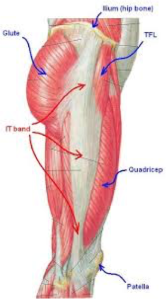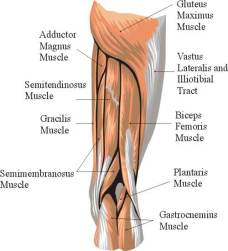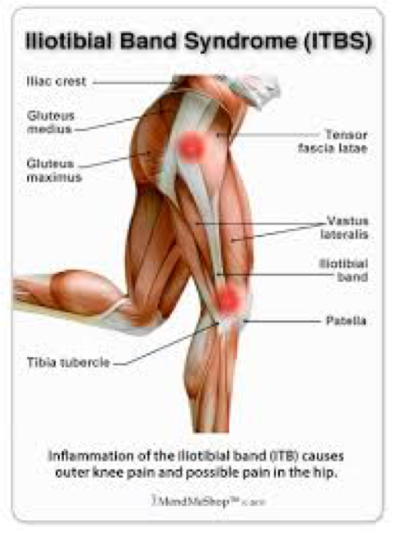This week topic in Mobility class will be the It band…..
Will we stretch it?
No
Will we roll it?
No
Will we learn why we think it’s giving us issues, and fix the other areas that may be leading to the issue?
Yes
Should you come to class if you are worried about IT band tightness, or are having issues either at the top outside of your hip, bottom outside portion of your knee, or anywhere down the side of your leg- YES!
Often when people have been told they have a tight IT band, they aren’t being told the ‘bigger story’. The bigger story to the IT band issue is that your IT band is supposed to be tight. Your IT band is a giant thick fibrous piece of fascia that stretches from your hip to your knee. The IT band contributes to lateral knee stabilization. If it wasn’t tight like it’s supposed to be, you wouldn’t have lateral knee stability! The muscles surrounding the It band perform a variety of functions including extending, abducting and laterally rotating the hips. When the muscles responsible for these motions are tight or weak your It band compensates to make the motion happen. As as result it seems like your IT band is the bad guy causing the problems, but really he is just trying to help!

The thick white tissues is the It band. As you can see it runs from the hip down to the knee. You can also note all the muscles on the front and back part of the leg that are connected through fascia tissue.

This is one of the functions of the It band and the muscles associated which cause abduction of the leg.
So why would you be told your IT band is tight and you need to roll and stretch it?
Well, when the surrounding muscles are tight, or weak and aren’t doing their job properly, the IT band compensates by becoming tighter, and moving in ways it shouldn’t. So basically, the IT band gets in trouble (tightens, or causes you pain) when other muscles are too weak or tight to be moving your body how it should, and as a result your It band, which is a big bad tissue down the side of the leg takes over, and because it’s so big and fibrous it can start to cause issues in the body.
Which muscles am I talking about that can cause the It band challenges?
The glute muscles (butt muscles) attach into the side of the hip onto the IT band. If any of the butt muscles are too tight, they will be pulling that IT band further back behind the body, making the IT band seem tighter. One of the first culprits to why our IT band may be called ‘tight’.
The lateral rotators of the hips are responsible for opening your hip (so that the inside of your foot is facing the front. They attach into the IT band, and together they are responsible for the same function. If these rotators are tight, again they will be pulling on the IT band.
The quadriceps, specifically the vastus lateralis also have a common insertion point on the lateral part of the knee. If this muscle has not been rolled (anatomically it makes more sense to massage/roll it then stretch it), then it’s tightness could be leading to further friction and challenges in the area in which you are feeling your It band pain on the side of the knee. And remember, all fascial tissue is connected throughout the body (like a giant spider web covering all your muscles). If you don’t release the fascia surrounding the vastus lateralis, than it’s connection to the It band will become tight.
What else can happen?
If the adductors and internal rotators (tensor fascia latea) become tight and weak, the structures that are on the other side (back side of the hip) compensate by becoming over stretched, and also weak. These structures on the back side of the hip are the gluteus medius and minimus. If they become over stretched, and therefore weak they can’t do their job to externally rotate the hip during motion, which as described before means the IT band and TFL (tensor fascia latea) will start to do too much of this motion for the leg, causing issues generally at it’s origin on the knee.

This picture shows the TFL, one of the structures that when it becomes tight can cause an overstretch and lack of strength in the back of the hip. It also can take over the job of the gluteus medius, causing even further tightness of the It band.
Another important muscle to ensure is stretched and mobilized correctly is the 3 muscles that make up the hamstrings. These muscles attach to the back and sides of the knee and should also be stretched regularly to ensure it is not leading to further complications at the medial and lateral knee.

The proper strength and stretch in the gastrocnemius should also be considered in terms of it’s affect on the It band. As you can see the calf muscles (gastrocnemius) attach on the back of the femur. Tightness or weakness here could change the way you move your lower leg, over time affecting how your IT band tracks over your knee.
Other biomechanical issues that may lead to IT band issues are: leg length discrepancy, lateral pelvic tilt and the angle of your pelvis to your knee. Pronation of the feet, which basically means your foot caves in and your arch collapses when you are weight bearing on your foot, can cause tissues like your It band to take the brunt.
On top of tightness in all of the muscles that attach into the IT band, we also need to consider these individuals muscles strength. For example, if your glute medius is quite weak (it’s role is to abduct the leg), then everytime you abduct your leg, the larger IT band may force the motion to happen, rather than what should be (glute medius). This is an example of overusing the IT band for a purpose that it isn’t designed or supposed to be focusing on. So not only do all the surrounding muscles need to be flexible and mobile, they also need to be strong. This is mostly an issue in the gluteus medius, which I just mentioned. Many people have a very hard time activating this muscle, and as a result can suffer from the biomechanical adaptations they may make due to this weakness.
Do I have my own personal interest in focussing on this today? Yep!
I have the following culprits in my right side:
– weak gluteus medius, tight semitendinosus, tight quads, and tight calves. It’s almost a never ending job to keep these structures stretched and rolled out when you are used to biking, hiking, and exercising regularly. Although sometimes it feels like a part time job, it is well worth it as I can decrease my lateral knee pain and inflammation.
Given everything I have covered in my explanation of the IT band, this Saturday in mobility class there will be a focus on:
- Stretching and rolling the glute max.
- Stretching, rolling, and strengthening the gluteus medius and minimus.
- Rolling out the vastus lateralis.
- Stetching the Biceps femoris
- Stretching and rolling semitendinosus.
- Stretching and rolling the gastrocnemius muscles.
- Rolling out the feet.
Next week I will post for you a description of all of the stretches, rolls and exercises we do for our It bands.
If you would like to join me in person, if you experience IT band, or lateral knee pain, the class takes place at #180-4255 Arbutus Street, Vancouver. Drop in fee is $20 per person.
And remember-
If you have pain or discomfort somewhere, don’t let it get you down. Don’t let it take away from your livelihood and your daily activities. Instead, educate yourself about what’s going on, seek out other practitioners who can support you and rid yourself of that pain!








T
LikeLike
The picture about the Hamstring muscles is incorrect. The semitendinosus muscle is not on the lateral side.
LikeLike
Was just going to comment on that as well
LikeLike
Thanks for pointing that out, I made a change of the photo and clarified my point!
LikeLike